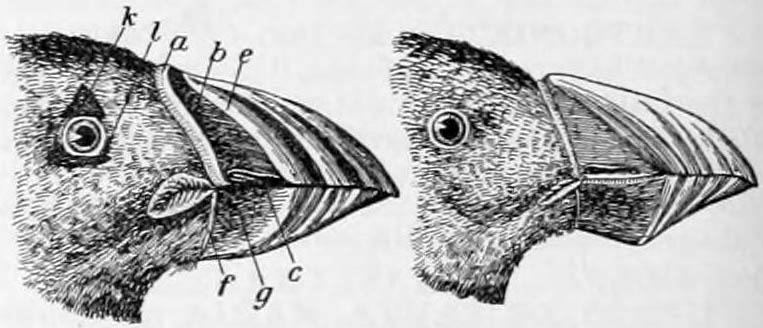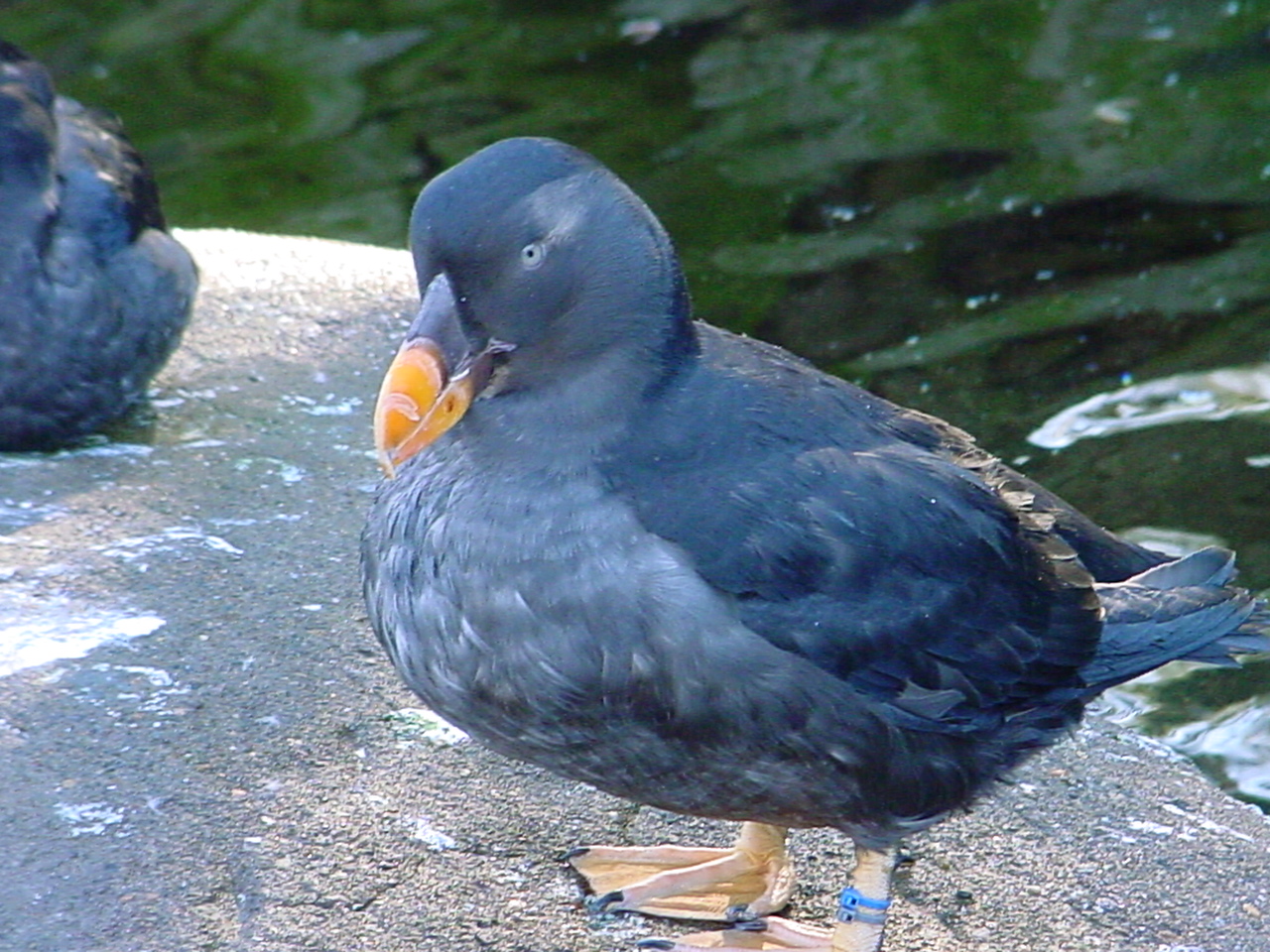|
Puffins
Puffins are any of three species of small alcids (auks) in the bird genus ''Fratercula''. These are pelagic seabirds that feed primarily by diving in the water. They breed in large colonies on coastal cliffs or offshore islands, nesting in crevices among rocks or in burrows in the soil. Two species, the tufted puffin and horned puffin, are found in the North Pacific Ocean, while the Atlantic puffin is found in the North Atlantic Ocean. All puffin species have predominantly black or black and white plumage, a stocky build, and large beaks that get brightly colored during the breeding season. They shed the colorful outer parts of their bills after the breeding season, leaving a smaller and duller beak. Their short wings are adapted for swimming with a flying technique underwater. In the air, they beat their wings rapidly (up to 400 times per minute) in swift flight, often flying low over the ocean's surface. Etymology The English name "puffin" – puffed in the sense of swoll ... [...More Info...] [...Related Items...] OR: [Wikipedia] [Google] [Baidu] |
Atlantic Puffin
The Atlantic puffin ('), also known as the common puffin, is a species of seabird in the auk family (biology), family. It is the only puffin native to the Atlantic Ocean; two related species, the tufted puffin and the horned puffin being found in the northeastern Pacific. The Atlantic puffin breeds in Russia, Iceland, Ireland, Great Britain, Britain, Norway, Greenland, Newfoundland and Labrador, Nova Scotia, and the Faroe Islands, and as far south as Maine in the west and France in the east. It is most commonly found in the Westman Islands, Iceland. Although it has a large population and a wide range, the species has declined rapidly, at least in parts of its range, resulting in it being rated as Vulnerable species, vulnerable by the IUCN. On land, it has the typical upright stance of an auk. At sea, it swims on the surface and feeds on zooplankton, small fish, and crabs, which it catches by diving underwater, using its wings for propulsion. This puffin has a black crown and bac ... [...More Info...] [...Related Items...] OR: [Wikipedia] [Google] [Baidu] |
Fratercula Arctica
The Atlantic puffin ('), also known as the common puffin, is a species of seabird in the auk family. It is the only puffin native to the Atlantic Ocean; two related species, the tufted puffin and the horned puffin being found in the northeastern Pacific. The Atlantic puffin breeds in Russia, Iceland, Ireland, Britain, Norway, Greenland, Newfoundland and Labrador, Nova Scotia, and the Faroe Islands, and as far south as Maine in the west and France in the east. It is most commonly found in the Westman Islands, Iceland. Although it has a large population and a wide range, the species has declined rapidly, at least in parts of its range, resulting in it being rated as vulnerable by the IUCN. On land, it has the typical upright stance of an auk. At sea, it swims on the surface and feeds on zooplankton, small fish, and crabs, which it catches by diving underwater, using its wings for propulsion. This puffin has a black crown and back, light grey cheek patches, and a white body and ... [...More Info...] [...Related Items...] OR: [Wikipedia] [Google] [Baidu] |
Horned Puffin
The horned puffin (''Fratercula corniculata'') is an auk found in the North Pacific Ocean, including the coasts of Alaska, Siberia and British Columbia. It is a pelagic seabird that feeds primarily by diving for fish. It nests in colonies, often with other auks. It is similar in appearance to the Atlantic puffin, its closest relative of the North Atlantic, but differs by a "horn" of black skin located above the eye, present in adult birds. Etymology The binomial name of this species, ''Fratercula corniculata'', comes from the Medieval Latin ''fratercula'', meaning “friar”; their black-and-white plumage resembling the robes of monks. ''Corniculata'' means “horn-shaped” or “crescent-shaped”, in reference to the black horn above the bird's eye. The vernacular name ''puffin'' – puffed in the sense of swollen – was originally applied to the fatty, salted meat of young birds of the unrelated species, the Manx shearwater (''Puffinus puffinus''), formerly known as the "M ... [...More Info...] [...Related Items...] OR: [Wikipedia] [Google] [Baidu] |
Tufted Puffin
The tufted puffin (''Fratercula cirrhata''), also known as crested puffin, is a relatively abundant medium-sized pelagic seabird in the auk family (Alcidae) found throughout the North Pacific Ocean. It is one of three species of puffin that make up the genus ''Fratercula'' and is easily recognizable by its thick red bill and yellow tufts. Description Tufted puffins are around in length with a similar wingspan and weigh about three-quarters of a kilogram (1.6 lbs), making them the largest of all the puffins. Birds from the western Pacific population are somewhat larger than those from the eastern Pacific, and male birds tend to be slightly larger than females. They are primarily black with a white facial patch, and, typical of other puffin species, feature a very thick bill, primarily red with some yellow and occasionally green markings. Their most distinctive feature and namesake are the yellow tufts () that appear annually on birds of both sexes as the summer reprod ... [...More Info...] [...Related Items...] OR: [Wikipedia] [Google] [Baidu] |
Bird Colony
A bird colony is a large congregation of individuals of one or more species of bird that nest or roost in proximity at a particular location. Many kinds of birds are known to congregate in groups of varying size; a congregation of nesting birds is called a breeding colony. Colonial nesting birds include seabirds such as auks and albatrosses; wetland species such as herons; and a few passerines such as weaverbirds, certain blackbirds, and some swallows. A group of birds congregating for rest is called a communal roost. Evidence of colonial nesting has been found in non- neornithine birds (Enantiornithes), in sediments from the Late Cretaceous (Maastrichtian) of Romania. Variations on colonial nesting in birds Approximately 13% of all bird species nest colonially. Nesting colonies are very common among seabirds on cliffs and islands. Nearly 95% of seabirds are colonial, leading to the usage, seabird colony, sometimes called a rookery. Many species of terns nest in colonies ... [...More Info...] [...Related Items...] OR: [Wikipedia] [Google] [Baidu] |
Molecular Clocks
The molecular clock is a figurative term for a technique that uses the mutation rate of biomolecules to deduce the time in prehistory when two or more life forms diverged. The biomolecular data used for such calculations are usually nucleotide sequences for DNA, RNA, or amino acid sequences for proteins. Early discovery and genetic equidistance The notion of the existence of a so-called "molecular clock" was first attributed to Émile Zuckerkandl and Linus Pauling who, in 1962, noticed that the number of amino acid differences in hemoglobin between different lineages changes roughly linearly with time, as estimated from fossil evidence. They generalized this observation to assert that the rate of evolutionary change of any specified protein was approximately constant over time and over different lineages (known as the molecular clock hypothesis). The genetic equidistance phenomenon was first noted in 1963 by Emanuel Margoliash, who wrote: "It appears that the number o ... [...More Info...] [...Related Items...] OR: [Wikipedia] [Google] [Baidu] |
Pamela C
Pamela commonly refers to: * '' Pamela; or, Virtue Rewarded'', a novel written by Samuel Richardson in 1740 * Pamela (name), a given name and, rarely, a surname. Pamela may also refer to: Arts, entertainment, and media Music * Pamela Spence, a Turkish pop-rock singer, known by her stage name "Pamela" *"Pamela Pamela", a song recorded by Wayne Fontana that reached number 11 in the UK Singles Chart in 1967 * "Pamela" (song), a 1988 hit song for the band Toto *"Pamella", a song by Remmy Ongala from the album ''Songs for the Poor Man'' *"Pamela Wan", a song composed by Vhong Navarro in 2004, inspired by the movie ''Otso-Otso Pamela-Mela-Wan'' Other entertainment and media * ''Pamela'' (film), a 1945 French film *'' Pamela, A Love Story'', an upcoming 2023 Netflix documentary about Pamela Anderson *'' Una donna da guardare'', a 1990 Italian erotic movie *'' P.A.M.E.L.A.'', a first-person survival video game Other * MSC ''Pamela'', a container ship launched in 2005 * ''Pamela'' (b ... [...More Info...] [...Related Items...] OR: [Wikipedia] [Google] [Baidu] |
Rhinoceros Auklet
The rhinoceros auklet (''Cerorhinca monocerata'') is a seabird and a close relative of the puffins. It is the only extant species of the genus ''Cerorhinca''. Given its close relationship with the puffins, the common name rhinoceros puffin has been proposed for the species. It ranges widely across the North Pacific, feeding on small fish and nesting in Bird colony, colonies. Its name is derived from a horn-like extension of the beak (the anatomic term for this extension is the Beak#Rhamphotheca, rhamphotheca). This horn is only present in breeding adults, and like the elaborate sheath on the bill of puffins is shed every year. This horn also possesses fluorescent properties, which is likely involved in reproductive signalling. The rhinoceros auklet (also known as the rhino auklet, horn-billed puffin, or unicorn puffin), is a medium-sized auk with a large, strong, orange/brown bill (with the 'horn' protruding from it). The plumage is dark on top and paler below; breeding adults ( ... [...More Info...] [...Related Items...] OR: [Wikipedia] [Google] [Baidu] |
Monk
A monk (; from , ''monachos'', "single, solitary" via Latin ) is a man who is a member of a religious order and lives in a monastery. A monk usually lives his life in prayer and contemplation. The concept is ancient and can be seen in many religions and in philosophy across numerous cultures. The Greek word for "monk" may be applied to men or women. In English, however, "monk" is applied mainly to men, while ''nun'' is typically used for female monastics. Although the term ''monachos'' is of Christianity, Christian origin, in the English language ''monk'' tends to be used loosely also for both male and female ascetics from other religious or philosophical backgrounds. However, being generic, it is not interchangeable with terms that denote particular kinds of monk, such as cenobite, hermit, anchorite, or Hesychasm, hesychast. Traditions of Christian monasticism exist in major Christian denominations, with religious orders being present in Catholicism, Lutheranism, Oriental Ort ... [...More Info...] [...Related Items...] OR: [Wikipedia] [Google] [Baidu] |
Manx Shearwater
The Manx shearwater (''Puffinus puffinus'') is a medium-sized shearwater in the seabird family Procellariidae. The scientific name of this species records a name shift: Manx shearwaters were called Manks puffins in the 17th century. Puffin is an Anglo-Norman language, Anglo-Norman word (Middle English ''pophyn'') for the Curing (food preservation), cured carcasses of nestling shearwaters. The Atlantic puffin acquired the name much later, possibly because of its similar nesting habits. Taxonomy The shearwaters form part of the family Procellariidae, a widespread group containing nearly 100 species of medium to large seabirds. They have long, narrow wings and the characteristic “tube nose”. Although it was considered a monotypic species, recently an endemic subspecies for the Canary Islands has been proposed ''P. puffinus canariensis''. The large genus ''Puffinus'' includes several species formerly considered to be subspecies of the Manx shearwater, including the yelkouan shea ... [...More Info...] [...Related Items...] OR: [Wikipedia] [Google] [Baidu] |






